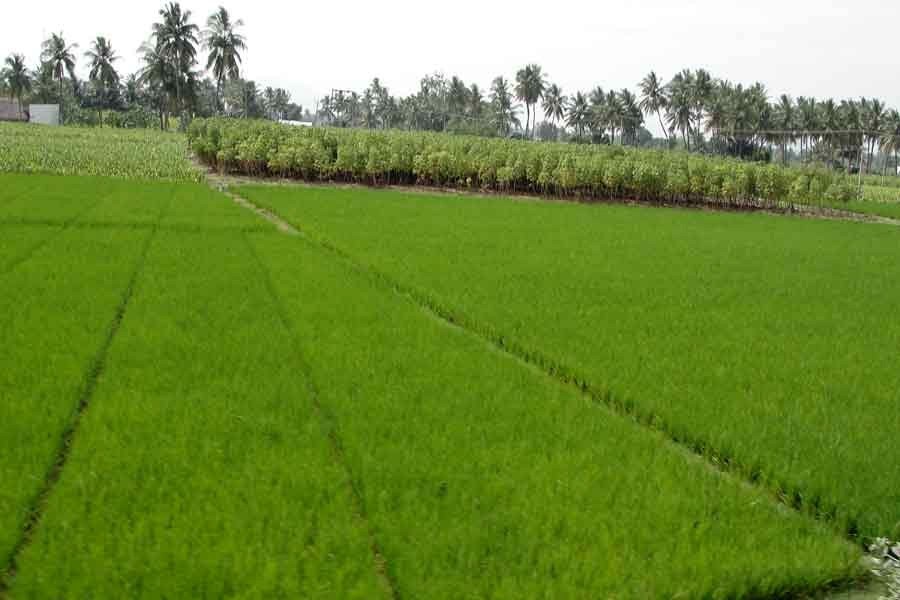Decisions on the choice of crops to be grown depend on land under command, yield and market prices. Rational farmers can maximise profits by minimising constraints. Have farmers changed cropping pattern over time as they are increasingly facing a declining land base? The question begs an answer for a number of reasons.
First, land is the scarcest of all assets. The existing high man-land ratio demands that limited land resource were used optimally for reaping the highest possible profit. Second, land is the most important asset that affects the livelihood of rural households. Therefore, an idea of a farmer's decision and its change related to land utilisation can shed some light on the rural ways of life.
In the distant past, traditional Aman paddy occupied more than half of the total cultivated land, followed by Aus paddy claiming about one-third. Therefore, four-fifth of the total cultivated land was occupied by traditional varieties (TVs) previously. On the contrary, less than one-fifth of land was devoted to HYV Boro and Aman (modern) paddy. The problems with TV paddy are that, they have lower yield and, to feed a growing family, farmers have to cultivate more land. This is just the opposite with HYVs that provide more output per unit of land.
But the pendulum swung soon and sharply when cultivated land under HYV Boro tripled and that of HYV Aman doubled within a short span of time. By and large, HYV Boro and Aman now account for four-fifth of the cultivated land thus capturing the position that was earlier held by TV paddy. The most dramatic development, however, could be evidenced in the most recent periods: over 90 per cent of land is cultivated with modern paddy. More prominently, cultivation of TV Aus-season crops has seen near elimination although the condition of TV Boro remains as it was before.
The '80s and '90s could be considered the "golden" period for modern paddy in this country. As said before, the economics of HYVs is very simple and straight forward: more production with less land and, hence, it is the savings of land for farmers. In other words, it is as if the amount of land under farmers tends to go up. Researchers reckon that the expansion of modern paddy and its adoption by rational farmers contributed significantly to ensuring food security over time.
But the clouds gathered in the distant horizon need to be addressed. For example, critics argue that cultivation of various non-rice crops --once accounting for a respectable share of the cultivated land --has been swept away by the 'tidal surge' of the MV paddy. That means, possibly led by the profit motive, farmers are now growing more of HYVs at the cost of other minor crops. In other words, crop diversification has been replaced by a mono-cropping system. In this context, daal (lentil) can be mentioned as it was occupying one-tenth of the cultivated land in the past. But now it claims only half of the base period. Likewise, though marginally, jute cultivation has also surrendered to paddy cultivation.
The views of the critics can be shared on two sides. First, and to reiterate, mono-cropping system adversely affects soil fertility and conversely, multi-cropping helps maintain the fertility balance. Second, for a balanced diet in everyday life, people need both rice and daal. While the growth of paddy output helped reduce the price of rice, at the same time, a reduction in the output of daal raised its price over time. This means that the lack of crop diversification has been leading to the lack of consumption diversification, especially for the poor households.
From a policy point of view, however, the most disturbing trend could be a decline in cropping intensity over time: from 168 in the base year to 153 in recent years. But much of the decline could be adduced to a drop in paddy cropping intensity. This means that farmers are no longer using land for paddy as enthusiastically as they did before. Under the circumstances, one can doubt the "self-sufficiency" paradigm.
But it can be reasoned that a fall in cropping intensity over time is due to three factors: first, the fall in paddy prices, and hence of profitability, over the years have constrained cultivation to a certain extent; second, the drastic reduction in the cultivation of deep-water Aman has lowered cropping intensity; third, the expansion in rural non-farm activities with better returns for households may have lured farmers to other sources and away from farming. Finally, there could have been minor shifts in land allocation towards non-rice crops which were yet to impart visible impacts on intensity.
An inclusive agricultural policy is needed where farmers tend to face equi-marginal returns from different types of crops grown. Too much emphasis on rice, for example, at the cost of other crops could hinder balanced growth of the sector. All crops should face equal treatment from research, infrastructure and marketing opportunities. This is the only way that farmers in Bangladesh will be better off.
Abdul Bayes is a former Professor of Economics at Jahangirannagr University.


